Nutmeg
 From Nwe
From Nwe | Nutmeg | ||||||||||||
|---|---|---|---|---|---|---|---|---|---|---|---|---|
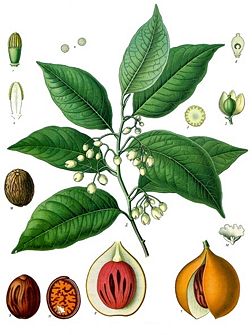
Myristica fragrans
|
||||||||||||
| Scientific classification | ||||||||||||
|
||||||||||||
|
|
||||||||||||
About 100 species, including:
|
Nutmeg is the common name for a dark-leaved evergreen tree, Myristica fragans, that is cultivated for two spices derived from its fruit, "nutmeg" and "mace." Nutmeg is produced from the dried, ripe, inner seed and mace from the seed coat (arillus) that separates the seed from its outer husk. The term nutmeg also is used to refer to just the seed of this tree or to the ground or grated spice developed from this seed. In addition, nutmeg is the name applied to members of the genus Myristica in general, while the family to which the genus belongs, Myristicaceae, is known as the nutmeg family.
In addition to being the source of the spices nutmeg and mace, Myristica fragans (common or true nutmeg) also is commercially important as a source of an essential oil and nutmeg butter. Other nutmegs in the genus, such as the Papuan nutmeg, M. argentea, and the Bombay nutmeg, M. malabarica, are of limited commercial value.
The term nutmeg also is applied to some trees in different genera, such as the California nutmeg (Torreya californica), which is not closely related to Myristica fragans'.
Nutmeg was extremely popular in much of the world from the fifteenth to the nineteenth centuries (Herbst 2001) and remains widely used today as a spice for food and drinks. As a culinary spice, with its unique aroma and taste, nutmeg has added to the human enjoyment of many foods. The essential oil and dried nut also are employed medicinally; however, the effectiveness of treatment versus the toxicity of overdoses makes its medicinal use generally not recommended. The risks associated with consuming too much nutmeg reflects on the importance of being informed regarding even easily obtained food items.
Description
The nutmegs, Myristica, are a genus of evergreen trees indigenous to tropical southeast Asia and Australasia. There are about 100 species in the genus.
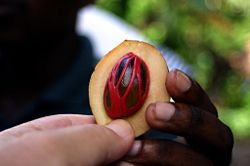
The most famous and commercially important member of this genus is the true nutmeg tree, Myristica fragrans, also known as the common or fragrant nutmeg. It is native to the Banda Islands of Indonesia. Today, it is grown in Indonesia, New Guinea, the West Indies, and southern Florida in the United States. The Papuan nutmeg, M. argentea, from New Guinea, and the Bombay nutmeg, M. malabarica, from India are both used as adulterants of M. fragrans products.
M. fragrans is moderately tall (15 meters or 50 feet), tropical, evergreen tree, with smooth, gray-brown bark and green leaves (DeMilto and Frey 2005). The oblong, fleshy fruit is golden-yellow when mature and is called the nutmeg apple (DeMilto and Frey 2005). The tree may bear fruit for more than 60 years.
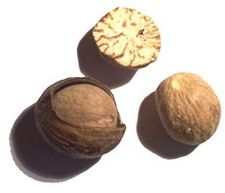
Inside the fruit, the seed of M. fragrans is roughly egg-shaped and about 20 millimeters (mm) to 30 mm (one inch) long and 15 mm to 18 mm (¾ inch) wide. It weighs between five grams and ten grams (¼ ounce and ½ ounce) dried. This hard seed is the source of the nutmeg spice, which involves removal from the fruit, drying, and grinding. The dried "lacy" reddish covering or arillus of the seed is the source of the spice mace.
Several other commercial products are also produced from nutmeg trees, including essential oils, extracted oleoresins, and nutmeg butter. Nutmeg butter is a mixture of fatty and essential oil and is made by chopping and steaming the nuts until a paste is formed (DeMilto and Frey 2005).
History
There is some evidence that Roman priests may have burned nutmeg as a form of incense, although this is disputed. It is known to have been used as a prized and costly spice in medieval cuisine. Saint Theodore the Studite (ca. 758 C.E. – ca. 826), was famous for allowing his monks to sprinkle nutmeg on their pease pudding when required to eat it. In Elizabethan times, it was believed that nutmeg could ward off the plague, so nutmeg was very popular. Nutmeg was traded by Arabs during the Middle Ages in the profitable Indian Ocean trade.
In the late fifteenth century, Portugal started trading in the Indian Ocean, including nutmeg, under the Treaty of Tordesillas with Spain and a separate treaty with the sultan of Ternate. But full control of this trade was not possible and they remained largely participants, rather than overlords since the authority Ternate held over the nutmeg-growing center of the Banda Islands was quite limited; therefore the Portuguese failed to gain a foothold in the islands themselves.
The trade in nutmeg later became dominated by the Dutch in the seventeenth century. The British and Dutch engaged in prolonged struggles and intrigue to gain control of Run island, then the only source of nutmegs. At the end of the Second Anglo-Dutch War the Dutch gained control of Run in exchange for the British controlling New Amsterdam (New York) in North America.
The Dutch managed to establish control over the Banda Islands after an extended military campaign that culminated in the massacre or expulsion of most of the islands' inhabitants in 1621. Thereafter, the Banda Islands were run as a series of plantation estates, with the Dutch mounting annual expeditions in local war-vessels to extirpate nutmeg trees planted elsewhere.
As a result of the Dutch interregnum during the Napoleonic Wars, the English took temporary control of the Banda Islands from the Dutch and transplanted nutmeg trees to their own colonial holdings elsewhere, notably Zanzibar and Grenada. Today, a stylized split-open nutmeg fruit is found on the national flag of Grenada.
Connecticut gets its nickname, "the nutmeg state," perhaps from the legend that some unscrupulous Connecticut traders would whittle "nutmeg" out of wood, creating a "wooden nutmeg," which they would sell (CSL 2005). Another explanation is that they actually sold nutmegs, but the buyers were unaware that these hard seeds had to be grated, thinking they would crack like walnuts, and then concluded they were simply wood (CSL 2005).
World production
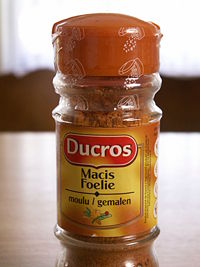
World production of nutmeg is estimated to average between 10,000 and 12,000 metric tons per year, with annual world demand estimated at 9,000 metric tons; production of mace is estimated at 1,500 to 2,000 tons. Indonesia and Grenada dominate production and exports of both products with a world market share of 75 percent and 20 percent respectively. Other producers include India, Malaysia, Papua New Guinea, Sri Lanka, and Caribbean islands such as St. Vincent. The principal import markets are the European Community, the United States, Japan, and India. Singapore and the Netherlands are major re-exporters.
At one time, nutmeg was one of the most valuable spices. It has been said that in England, several hundred years ago, a few nutmeg nuts could be sold for enough money to enable financial independence for life.
The first harvest of nutmeg trees takes place seven to nine years after planting and the trees reach their full potential after 20 years.
Uses
Myristica fragrans provides products of culinary value in terms of whole or ground nutmeg, mace, butter, and essential oil. The essential oil is used in perfumes, medicines, and dentifrices. While nutmeg has been used traditionally for medicinal purposes, actual effectiveness is largely unproven, and there are a number of precautions regarding its use, given possible toxic symptoms. (See risks and toxicity.)
Culinary uses
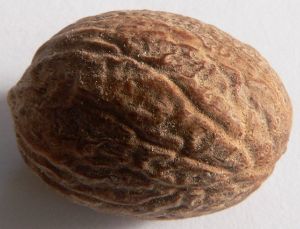
As a spice, nutmeg and mace have similar taste qualities, nutmeg having a slightly sweeter and mace a more delicate flavor. Mace is often preferred in light-colored dishes for the bright orange, saffron-like color it imparts. Nutmeg, which can be purchased whole or ground, is a flavorful addition to cheese sauces and is best grated or ground fresh from whole nutmeg. It may be used in custards, baked goods, on potatoes, or in eggnog, among numerous applications.
In Indian cuisine, nutmeg powder is used almost exclusively in sweet dishes. It is known as Jaiphal in most parts of India and Jathi seed in Kerala. It may also be used in small quantities in garam masala.
In Middle Eastern cuisine, nutmeg powder is often used as a spice for savory dishes. In Arabic, nutmeg is called Jawz at-Tiyb.
In European cuisine, nutmeg and mace are used especially in potato dishes and in processed meat products; they are also used in soups, sauces, and baked goods. In Dutch cuisine, nutmeg is quite popular, and is added to vegetables like Brussels sprouts, cauliflower, and string beans.
Japanese varieties of curry powder include nutmeg as an ingredient, and a Norwegian bun called kavring includes nutmeg. Furthermore, nutmeg is a traditional ingredient in mulled cider, mulled wine, and eggnog.
The pericarp (fruit/pod) of Myristica fragrans is used in Grenada to make a jam called morne delice. In Indonesia, the fruit is sliced finely, cooked, and crystallized to make a fragrant candy called manisan pala ("nutmeg sweets").
Nutmeg butter
Nutmeg butter is obtained from the nut by expression. It is semi-solid and reddish brown in color and tastes and smells of nutmeg. Approximately 75 percent (by weight) of nutmeg butter is trimyristin, which can be turned into myristic acid, a 14-carbon fatty acid that can be used as replacement for cocoa butter, can be mixed with other fats like cottonseed oil or palm oil, and has applications as an industrial lubricant.
Essential oils
The essential oil of M. fragrans is obtained by the steam distillation of ground nutmeg and is used heavily in the perfumery and pharmaceutical industries.
The oil is colorless or light yellow and smells and tastes of nutmeg. It contains numerous components of interest to the oleochemical industry, and is used as a natural food flavoring in baked goods, syrups, beverages, sweets, and so forth. The essential oil replaces ground nutmeg as it leaves no particles in the food. The essential oil is also used in the cosmetic and pharmaceutical industries, for instance in tooth paste and as major ingredient in some cough syrups.
Medicinal use
In traditional medicine, nutmeg and nutmeg oil were used for illnesses related to the nervous and digestive systems. It is used in both Western and Chinese herbal medicine (DeMilto and Frey 2005). It has been said to relax the muscles, remove gas from the digestive system, sedate the body, and to be of value for such stomach problems as indigestion (DeMilto and Frey 2005). It is also used for chronic nervous disorders, to prevent nausea and vomiting, and for kidney disorders, and in Chinese medicine is used for diarrhea, inflammation, abdominal pain, and liver disease, among other aliments (DeMilto and Frey 2005).
Nutmeg is used medicinally in powders, capsule, and essential oil.
Externally, the oil is used for rheumatic pain and, like clove oil, can be applied as an emergency treatment to dull toothache. Drops are put on a cotton swab, and applied to the gums around an aching tooth until dental treatment can be obtained. In France, it is given in drop doses in honey for digestive upsets and used for bad breath. Drops are put on a sugar lump or in a teaspoon of honey for nausea, gastroenteritis, chronic diarrhea, and indigestion. Alternatively a massage oil can be created by diluting the essential oil in almond oil. This is sometimes for muscular pains associated with rheumatism or overexertion. It is also combined with thyme or rosemary essential oils. It is an ingredient in medicines such as Vicks Vaporub and Nervospur.
It should be noted that these are folk remedies. DeMilto and Frey (2005) note that although nutmeg is used for a variety of aliments, it "hasn't been proven to be useful or effective for any and it can be harmful." Furthermore, nutmeg when ingested can be fatal and when applied to the skin it can be an irritant.
Myristicin and elemicin are believed to be the chemical constituents responsible for the subtle hallucinogenic properties of nutmeg oil. Other known chemical ingredients of the oil are α-pinene, sabinene, γ-terpinene, and safrole.
Risks and toxicity
DeMilto and Frey (2005) do not recommend nutmeg as a medicine "because it is too risky; An overdose of nutmeg is harmful and sometimes deadly. There are more effective treatments for all of the ailments that nutmeg could be used for."
In low doses, nutmeg produces no noticeable physiological or neurological response. Large doses of 60 g (~12 teaspoons) or more are dangerous, potentially inducing convulsions, palpitations, nausea, eventual dehydration, and generalized body pain (Demetriades et al. 2005). In amounts of 10-40 g (about four to eight teaspoons), it is a mild to medium hallucinogen, producing visual distortions and a mild euphoria. Nutmeg contains myristicin, a weak monoamine oxidase inhibitor.
A test was carried out on the substance that showed that, when ingested in large amounts, nutmeg takes on a similar chemical make-up to MDMA (ecstasy). However, use of nutmeg as a recreational drug is unpopular due to its unpleasant taste and its side effects, including dizziness, flushes, dry mouth, accelerated heartbeat, temporary constipation, difficulty in urination, nausea, and panic. A user will not experience a peak until approximately six hours after ingestion, and effects can linger for up to three days afterwards.
A risk in any large-quantity (over 25 g, about five teaspoons) ingestion of nutmeg is the onset of "nutmeg poisoning," an acute psychiatric disorder marked by thought disorder, a sense of impending doom/death, and agitation. Some cases have resulted in hospitalization. For such reasons, DeMilto and Frey state that nutmeg should be used with caution with patients with psychiatric illness.
Fatal doses in children are significantly lower, with an eight-year-old boy who consumed just two nutmegs falling into a coma and dying 20-hours later (Cushy 1908).
Nutmeg is an abortifacient, and as such any significant doses should be avoided by pregnant women (Demetriades et al. 2005; DeMilto and Frey 2005).
DeMilto and Frey (2005) note that early symptoms of a nutmeg overdose (one to three nuts) are thirst, feeling of urgency, and nausea, and possible mild to intense hallucinations and a stupor that lasts from two to three days.
References
ISBN links support NWE through referral fees
- Connecticut State Library (CSL). 2005. Connecticut's nicknames: The nutmeg state Connecticut State Library. Retrieved April 7, 2008.
- Cushny, A. R. 1908. Nutmeg poisoning Proc R Soc Med. 1(Ther Pharmacol Sect): 39–44. Retrieved April 7, 2008.
- Demetriades et al. 2005. Low cost, high risk: Accidental nutmeg intoxication Emerg Med J. 22: 223-225.
- DeMilto, L., and R. J. Frey. 2005. In J. L. Longe (ed.), The Gale Encyclopedia of Alternative Medicine. Farmington Hills, Mich: Thomson/Gale. ISBN 0787693960.
- Gable, R. S. 2006. The toxicity of recreational drugs. American Scientist 94: 206–208.
- Herbst, S. T. 2001. The New Food Lover's Companion: Comprehensive Definitions of Nearly 6,000 Food, Drink, and Culinary Terms. Barron's Cooking Guide. Hauppauge, NY: Barron's Educational Series. ISBN 0764112589.
- Shulgin, A. T., T. W. Sargent, and C. Naranjo. 1967. Chemistry and psychopharmacology of nutmeg and of several related phenylisopropylamines. United States Public Health Service Publication 1645: 202–214.
| Herbs and spices | |
|---|---|
| Herbs | Angelica • Basil • Basil, holy • Basil, Thai • Bay leaf • Boldo • Borage • Cannabis • Chervil • Chives • Coriander leaf (cilantro) • Curry leaf • Dill • Epazote • Eryngium foetidum (long coriander) • Hoja santa • Houttuynia cordata (giấp cá) • Hyssop • Lavender • Lemon balm • Lemon grass • Lemon verbena • Limnophila aromatica (rice paddy herb) • Lovage • Marjoram • Mint • Mitsuba • Oregano • Parsley • Perilla (shiso) • Rosemary • Rue • Sage • Savory • Sorrel • Stevia • Tarragon • Thyme • Vietnamese coriander (rau răm) • Woodruff |
| Spices | African pepper • Ajwain (bishop's weed) • Aleppo pepper • Allspice • Amchur (mango powder) • Anise • Aromatic ginger • Asafoetida • Camphor • Caraway • Cardamom • Cardamom, black • Cassia • Cayenne pepper • Celery seed • Chili • Cinnamon • Clove • Coriander seed • Cubeb • Cumin • Cumin, black • Dill seed • Fennel • Fenugreek • Fingerroot (krachai) • Galangal, greater • Galangal, lesser • Garlic • Ginger • Grains of Paradise • Horseradish • Juniper berry • Liquorice • Mace • Mahlab • Malabathrum (tejpat) • Mustard, black • Mustard, brown • Mustard, white • Nasturtium • Nigella (kalonji) • Nutmeg • Paprika • Pepper, black • Pepper, green • Pepper, long • Pepper, pink, Brazilian • Pepper, pink, Peruvian • Pepper, white • Pomegranate seed (anardana) • Poppy seed • Saffron • Sarsaparilla • Sassafras • Sesame • Sichuan pepper (huājiāo, sansho) • Star anise • Sumac • Tasmanian pepper • Tamarind • Turmeric • Wasabi • Zedoary |
Credits
New World Encyclopedia writers and editors rewrote and completed the Wikipedia article in accordance with New World Encyclopedia standards. This article abides by terms of the Creative Commons CC-by-sa 3.0 License (CC-by-sa), which may be used and disseminated with proper attribution. Credit is due under the terms of this license that can reference both the New World Encyclopedia contributors and the selfless volunteer contributors of the Wikimedia Foundation. To cite this article click here for a list of acceptable citing formats.The history of earlier contributions by wikipedians is accessible to researchers here:
- Nutmeg history
The history of this article since it was imported to New World Encyclopedia:
- History of "Nutmeg"
Note: Some restrictions may apply to use of individual images which are separately licensed.
↧ Download as ZWI file | Last modified: 02/04/2023 07:39:45 | 37 views
☰ Source: https://www.newworldencyclopedia.org/entry/Mace | License: CC BY-SA 3.0
 ZWI signed:
ZWI signed: KSF
KSF